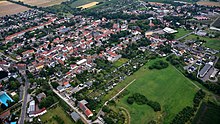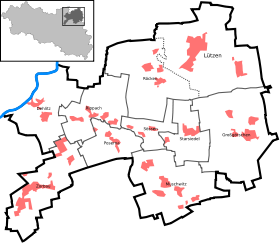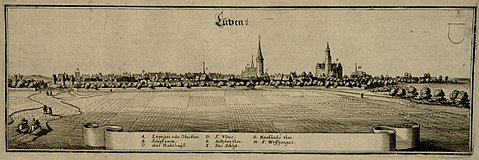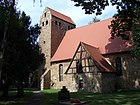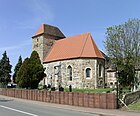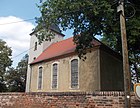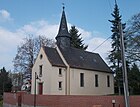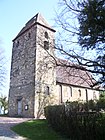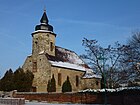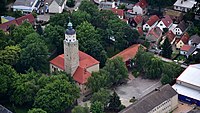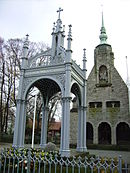Lützen
| coat of arms | Germany map | |
|---|---|---|

|
Coordinates: 51 ° 15 ' N , 12 ° 8' E |
|
| Basic data | ||
| State : | Saxony-Anhalt | |
| County : | Burgenland district | |
| Height : | 121 m above sea level NHN | |
| Area : | 96.49 km 2 | |
| Residents: | 8523 (Dec. 31, 2019) | |
| Population density : | 88 inhabitants per km 2 | |
| Postcodes : | 06679, 06686 | |
| Primaries : | 034441, 034444, 03443 (Dehlitz, Poserna, Rippach) | |
| License plate : | BLK, HHM, NEB, NMB, WSF, ZZ | |
| Community key : | 15 0 84 315 | |
| LOCODE : | DE SXZ | |
| City structure: | 34 districts | |
City administration address : |
Markt 1 06686 Lützen |
|
| Website : | ||
| Mayor : | Uwe Weiß ( SPD ) | |
| Location of the city of Lützen in the Burgenland district | ||
Lützen is a town in the Burgenland district in Saxony-Anhalt .
geography
Geographically, Lützen is part of the Leipzig lowland bay. The city is located about 10 kilometers southwest of the city limits of Leipzig on the federal highway 87 , which leads from Weißenfels via Lützen and Markranstädt to Leipzig. Lützen is also connected to the Federal Motorway 9 via the Bad Dürrenberg junction (approx. 5 km away) and to the A 38 via the Lützen junction (approx. 1 km away) .
Neighboring communities
| Bad Dürrenberg ( SK ) | ||
| Weissenfels |

|
Markranstädt and Kitzen (both L ) |
| Hohenmölsen and Teuchern |
Community structure
| Locality | Residents | Districts |
The localities of Lützen (clickable map) |
|---|---|---|---|
| Dehlitz | 544 | Dehlitz, Lösau and Oeglitzsch | |
| Großgörschen | 819 | Großgörschen, Kleingörschen , Rahna and Kaja | |
| Lützen | 3,705 | ||
| Muschwitz | 1,089 | Göthewitz, Muschwitz, Kreischau, Pobles, Söhesten, Tornau and Wuschlaub | |
| Meuchen | 260 | Meuchen | |
| Poserna | 384 | Poserna | |
| Rippach | 661 | Großgöhren , Kleingöhren , Pörsten and Rippach | |
| Skirts | 661 | Röcken, Bothfeld, Michlitz and Schweßwitz | |
| Sauces | 226 | Gostau, Sössen and Stößwitz | |
| Starsiedel | 677 | Kölzen and Starsiedel | |
| Zorbau | 810 | Gerstewitz, Nellschütz, Zorbau and Zörbitz. |
history
The town of Lützen had belonged to the Merseburg Monastery since the 13th century and was the seat of the Lützen episcopal office . Through the secularization of the diocese of Merseburg, the city of Lützen and the office of Lützen became part of the Electorate of Saxony .
In the 1580s, epidemics ravaged the region, such as an epidemic brain infection in 1583 and the plague in 1585. After the executioner had also fallen victim in late summer, his servant accused the dead bearer Melchior Schimpf of using the deceased's right thumb Palms bent and mumbled something unintelligible. Because of this unmistakable index for plague magic, the city court determined against Schimpf. His wife Ursula also came into the focus of the investigators because she was able to alleviate the suffering of plague sufferers with an unknown root. Under the torture , Melchior Schimpf confessed not only to having bent his thumb in the palm of many other dead, but also to the corpse of a deceased girl with the magic formula "I'll stick you in all the devil took 200 people who are to die afterwards" to have put a cloth in the mouth, whereby 200 more people were killed by the plague. He was instigated by his wife, who is a witch. The torture forced him to confess his allegiance to the devil and attend the witches' sabbath . She also confessed to cooking the plague bumps from the dead with the heads of rabbits and weasels and pouring the brew into houses to kill people. The couple were convicted and burned at the stake on November 10, 1585 .
In 1621 the city had a kipper mint, in which interim coins (kipper coins) were probably struck under mint master Wilhelm Quendel. Well known are single and double Kipper- Schreckenberger with the mint master's mark “Cross from four L”.
In 1632 Lützen was the scene of the Battle of Lützen , one of the main battles of the Thirty Years War . The Swedish King Gustav II Adolf fell in this battle. A chapel and a memorial commemorate the king. Since Napoleon spent the night before the Battle of Großgörschen (May 2, 1813) demonstratively at the memorial stone for Gustav Adolf, surrounded by his troops, this is sometimes referred to as the Battle of Lützen .
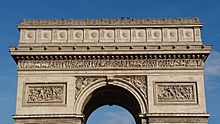
After the defeat of Napoleon and the allied Kingdom of Saxony , the Kingdom of Saxony had to cede a large part of its territory to the Kingdom of Prussia following a resolution by the Congress of Vienna in 1815 . The office Lützen was divided. The larger western part of the town Lützen was the Prussian province of Saxony ( Merseburg in the administrative district of Merseburg attached), the smaller eastern part came to the Saxon Office Leipzig .
Until the administrative reform of the GDR in 1952, Lützen belonged to the Merseburg district. Then the city belonged to the Weißenfels district in the Halle district and from 1990 in the state of Saxony-Anhalt . From 1994 Lützen belonged to the Weißenfels district . After the second district reform in the state of Saxony-Anhalt, Lützen has been in the Burgenland district since 2007 .
- Incorporations
On June 1, 1973 Meuchen was incorporated.
On July 1, 2009, the previously independent community of Röcken was incorporated.
On January 1, 2010, the city of Lützen was formed from the merger of Lützen with the previously independent communities Großgörschen , Muschwitz , Poserna , Rippach and Starsiedel .
On January 1, 2011 the communities Dehlitz , Sössen and Zorbau were incorporated.
religion
According to the 2011 census, 16% of the inhabitants are Protestant regional churches, 2% Roman Catholic.
The Protestant churches in Bothfeld, Dehlitz, Großgörschen, Großgöhren, Kleingörschen, Lützen, Meuchen, Pobles, Pörsten , Poserna, Röcken, Starsiedel and Treben make up the parish area of Lützener Land in the Merseburg parish of the Evangelical Church in Central Germany . The churches in Gerstewitz, Nellschütz and Zorbau belong to the parish of Weißenfels- Südost in the same church district. The churches in Göthewitz and Muschwitz are assigned to the parish Hohenmölsen in the parish of Naumburg-Zeitz .
- Evangelical churches in the city of Lützen
The Catholic Church of St. Joseph in Lützen was de-dedicated in 2013. The few Catholics in the city are now assigned to the parish of St. Elisabeth , based in Weißenfels, diocese of Magdeburg .
politics
City council
The city council of the city of Lützen consists of 20 honorary members and the mayor.
The election to the city council on May 26, 2019 led to the following result:
| Party / group of voters | Share of votes | +/-% p | Seats | +/- | |
|---|---|---|---|---|---|
| Christian Democratic Union of Germany (CDU) | 20.0% | - 8.9 | 4th | - 2nd | |
| Social Democratic Party of Germany (SPD) | 14.7% | - 0.6 | 3 | ± 0 | |
| The left | 8.9% | - 3.4 | 2 | ± 0 | |
| Alliance 90 / The Greens (GREENS) | 8.0% | + 0.2 | 2 | + 1 | |
| National Democratic Party of Germany (NPD) | 6.5% | + 3.6 | 1 | ± 0 | |
| Free Democratic Party (FDP) | 5.3% | + 2.5 | 1 | ± 0 | |
| Citizens List Lützen 1 | 36.6% | + 6.7 | 7th | + 1 | |
| Turnout: 59.3% (+ 10.0% p) | |||||
1 2014: Various groups of voters
mayor
The full-time mayor of the city of Lützen has been Uwe Weiß (SPD) since 2017. He prevailed against Nico Neuhaus with 53.2% of the vote.
coat of arms
The coat of arms was approved by the district on January 25, 2010.
Blazon : “In gold, growing out of the lower edge of the shield, nimbly silvered, John the Baptist with black hair and beard, in a blue robe over a black belted silver undergarment; with his right hand pointing to the gold nimbly, silver lamb of God resting on his left forearm on a silver book with a victory flag - red cross on silver - on the red cross staff. "
The colors of the city are blue - yellow.
flag
The flag is blue-yellow (1: 1) striped (longitudinal shape: stripes running vertically, transverse shape: stripes running horizontally) and centered with the city's coat of arms.
Sights / tourism
lock
Lützen Castle was built by the Merseburg bishops at the end of the 13th century . Since 1928 it has housed the City and Regional History Museum. This commemorates the two globally important battles near Lützen. This is once the battle of Lützen in 1632, in which the legendary King of Sweden Gustav II Adolf lost his life. A large diorama with 3,600 tin figures shows the battle. The other is the battle of Großgörschen from 1813, which is represented in an even larger diorama (5,500 tin figures). Another exhibition in the museum is dedicated to the poet and writer Johann Gottfried Seume . The building also houses the historical city archive.
Gustav Adolf Memorial
The memorial is dedicated to the Swedish King Gustav II Adolf, who fell during the Battle of Lützen. As early as 1632, the year of his death, a large boulder was erected as the first memorial at the place of death. In 1837 the inauguration of the cast iron canopy designed by Karl Friedrich Schinkel , which was erected over the so-called "Schwedenstein", took place. In 1907 the Gustav Adolf Chapel, donated by the Swedish consul Oskar Ekman and his wife Maria, was added. Two more typically Swedish wooden houses followed later. The occasional claim that the property belongs to the Swedish state or is even an extraterritorial area is a modern legend . In fact, from 1932 to the mid-1990s, the memorial was operated by the private Swedish Stiftelsen Lützenfonden (Lützenstiftung) based in Gothenburg . Since then, the foundation and the city of Lützen have taken care of the maintenance together.
Gustav Adolf Memorial Church in Meuchen
The originally Romanesque church was built in the 15th and 16th centuries. It was rebuilt in the Gothic style in the 19th century and redesigned as a memorial church in 1912. Behind the altar is an old wooden table on which the body of Gustav II Adolf is said to have been lying during the cleansing. A colored window and a bronze relief of the Swedish king are further exhibits.
Memorials of the Battle of Großgörschen in 1813
The Scharnhorst monument, the Schinkel pyramid, the monument to Prince Leopold von Hessen-Homburg and the Marschall-Ney-Haus are the most important monuments that commemorate the battle .
Town hall of Lützen
The town hall was built in 1884/1885 in the neo-renaissance style. The meeting room, the mayor's office and three preserved prison cells are still from the original furnishings. The west side of the town hall is decorated with a statue of Gustav Adolf.
Other memorials
- Nietzsche memorial in Röcken
- Memorial stone from 1946 on the grounds of the sugar factory in memory of twelve Soviet prisoners of war who were victims of forced labor here
- Monument from 1951 in the castle park ( Thälmannpark during GDR times ) for those persecuted by the Nazi regime by the sculptor Lichtenfels from Halle
City church St. Viti in Lützen
The construction of the late Gothic church began in 1488 on the site of a previous Romanesque building from the 13th century, and the church was consecrated in 1513. Construction of the tower began in 1513 and was completed in 1531. After a lightning strike in 1778, the initially 77 m high tower was shortened by 10 m.
Animal enclosure in Martzschpark
- Animal enclosure: Deer, aurochs, donkeys, ornamental birds and various small animals can be seen in the approx. 32 hectare area. The near-natural enclosure is a popular excursion destination, located in the immediate vicinity of the Gustav Adolf Memorial on the B87 and has sufficient parking spaces.
Bike paths
- The Sole-Coal History cycle path leads via Bad Dürrenberg to Geiseltalsee .
- The paved Elster-Saale cycle path runs along the embankment of the disused Leipzig-Plagwitz-Pörsten railway line to the outskirts of Leipzig in Lausen .
schools
There are four schools in Lützen, the Gustav Adolf Comprehensive School and elementary schools in Lützen, Großgöhren and Großgörschen. Until 1999 there was the Gustav-Adolf-Gymnasium in Lützen, which had to cease operations due to insufficient student numbers.
Sports clubs
- TSV Eintracht Lützen
- 1. Lützen Carneval Club 1985 eV
- Lützen has a future eV
- Privileged shooting guild Lützen1608 eV
Personalities
Web links
Individual evidence
- ↑ State Statistical Office Saxony-Anhalt, population of the municipalities - as of December 31, 2019 (PDF) (update) ( help ).
- ↑ a b c d Manfred Wilde : The sorcery and witch trials in Saxony . Böhlau, Cologne / Weimar / Vienna 2003, ISBN 3-412-10602-X , p. 201 ( limited preview in Google Book search).
- ↑ Wilde: sorcery and witch trials . Cologne / Weimar / Vienna 2003, p. 260 .
- ^ The district of Merseburg in the municipal directory 1900
- ^ Meuchen on gov.genealogy.net
- ↑ StBA: Area changes from January 2nd to December 31st, 2009
- ↑ StBA: Area changes from January 01 to December 31, 2010
- ↑ 2011 census
- ↑ Official Journal of the City of Lützen from June 13, 2019, page 3 and public announcement of the results of the election to the City Council of Lützen on May 25, 2014
- ↑ https://www.mz-web.de/burgenlandkreis/wahl-in-luetzen-neuer-buergermeister--uwe-weiss-wird-chef-im-rathaus-28595832
- ↑ a b Official Journal of the State Administrative Office of Saxony-Anhalt No. 2/2010, page 29 ( Memento from April 2, 2015 in the Internet Archive ) (PDF; 5.6 MB)
- ↑ Nina Fehrlen: The conception of the "Schwedenstraße" as a German-Swedish memorial of the Thirty Years' War. In: Janina Fuge u. a .: memory spaces. Images of history and cultures of remembrance in Northern Germany. V&R unipress, Göttingen 2014, pp. 385–404, on p. 400.



